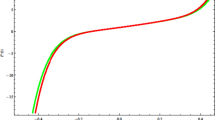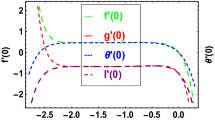Abstract
The nanofluid analysis has been carried out as a function of temperature and this idea is utilized to study the graphene oxide (GO) water-based nanofluid from both experimental and numerical perspectives. Various spectral investigations were used to endorse the successful synthesis of graphene oxide. The obtained GO exhibits large size platelet morphology with stable dispersion in water. The experimental procedure of the preparation of nanofluid and its outputs has been analyzed with numerical data. The obtained results from the Chebyshev spectral scheme were transformed into a mathematical model considering the 3D flow of the dispersed GO nanofluid between two parallel rotating disks using the governing Navier–Stokes equations and energy equation with the utilization of Von Karman similarity transformations. The obtained nonlinear differential equations have been examined through a recently fashionable analytic approximation method called the Optimal Homotopy Analysis Method (OHAM). Opposite and same direction rotational effects have been conferred on the flow characteristics. To analyze how the velocities, pressure and temperature fields are affected by various parameters, plots have been displayed. Convergence of the obtained results has been authenticated with residual errors physically and numerically. Moreover, the physical parameters impact, such as local Nusselt number and skin friction coefficients are obtained through numerical data and inspect.

















Similar content being viewed by others
References
Alshomrani AS, Gul T (2017) The Convective Study of the Al2O3-H2O and Cu-H2O nano-liquid film sprayed over a stretching cylinder with viscous dissipation. Eur Phys J Plus 132:495–517
Baby TT, Ramaprabhu S (2010) Investigation of thermal and electrical conductivity of graphene based nanofluids. J Appl Phys 108(12):124308
Balandin AA, Ghosh S, Bao W, Calizo I, Teweldebrhan D, Miao F, Lau CN (2008) Superior thermal conductivity of single-layer graphene. Nano Lett 8(3):902–907
Bilal S, Fahim M, Firdous I, Anwar-ul-Haq A, Shah A (2018) Insight into capacitive performance of polyaniline/graphene oxide composites with ecofriendly binder. Appl Surf Sci 435:91–101
Brinkman HC (1952) The viscosity of concentrated suspensions and solutions. J Chem Phys 20(4):571
Choi SUS, Eastman JA (1995) Enhancing thermal conductivity of fluids with nanoparticles. In: the proceedings of the 1995 ASME international mechanical engineering congress and exposition, San Francisco ASME, USA, 1995, pp 99–105, FED 231/MD 66
Fang T (2007) Flow over a stretchable disk. Phys Fluids 19:128105
Geim AK, Novoselov KS (2007) The rise of graphene. Nat Mater 6(3):183–191
Hatami M, Sheikholeslami M, Gangi DD (2014) Laminar flow and heat transfer of nanofluids between contracting and rotating disks by least square method. Power Technol 253:769–779
Hosseini SR, Sheikholeslami M, Ghasemian M, Ganji DD (2018) Nanofluid heat transfer analysis in a micro channel heat sink (MCHS) under the effect of magnetic field by means of KKL model. Powder Tech 324:36–47
Hummers WS, Offeman RE (1958) Preparation of graphitic oxide. J Am Chem Soc 80:1339
Ijam A, Saidur R, Ganesan P, Moradi Golsheikh A (2015) Stability, thermo-physical properties, and electrical conductivity of graphene oxide-deionized water/ethylene glycol based nanofluid. Int J Heat Mass Trans 87:92–103
Iqbal Z, Azhar E, Mehmood Z, Maraj EN, Kamran A (2017) Computational analysis of engine-oil based magnetite nanofluid problem inspired with entropy generation. J Mol Liq 230:295–304
Khan WA, Pop I (2010) Boundary layer.flow of a nanofluid past a stretching sheet. Int J Heat Mass Transf 53:2477–2483
Lance GN, Rogers MH (1962) The axially symmetric flow of a viscous fluid between two infinite rotating disks. Proc R Soc A 266:109–121
Lee S, Choi SUS, Li S, Eastman JA (1999) Measuring thermal conductivity of fluids containing oxide nanoparticles. J Heat Transf 121(2):280–289
Li ZF, Zhang H, Liu Q, Liu Y, Stanciu L, Xie J (2014) Covalently-grafted polyaniline on Graphene oxide sheets for high performance electrochemical super capacitors. Carbon 71:257–267
Liao SJ (2010) An optimal homotopy-analysis approach for strongly nonlinear differential equations. Commun Nonlinear Sci Numer Simul 15:2003–2016
Liu J, Wang F, Zhang L, Fang X, Zhang Z (2014) Thermodynamic properties and thermal stability of ionic liquid-based nanofluids containing graphene as advanced heat transfer fluids for medium-to-high-temperature applications. Renew Energy 63:519–523
Maraj EN, Shaiq S, Iqbal Z (2018) Assessment of hexahedron and lamina shaped graphene oxide nanoparticles suspended in ethylene and propylene glycol influenced by internal heat generation and thermal deposition. J Mol Liq. https://doi.org/10.1016/j.molliq.2018.04.072
Mustafa M, Hayat T, Pop I, Asghar S, Obaidat S (2011) Stagnation-point flow of a nanofluid towards a stretching sheet. Int J Heat Mass Transf 54:5588–5594
Nasir S, Islam S, Gul T, Shah Z, Khan MA, Khan W, Khan AZ, Khan S (2018) Three dimensional rotating flow of MHD single wall carbon nanotubes over a stretching sheet in presence of thermal radiation. Appl Nanosci. https://doi.org/10.1007/s13204-018-0766-0
Paredes JI, Villar-Rodil S, Martínez-Alonso A, Tascón JMD (2008) Graphene oxide dispersions in organic solvents. Langmuir 24:10560–10564
Rashidi MM, Kavyani N, Abelman S (2014) Investigation of entropy generation in MHD and slip flow over rotating porous disk with variable properties. Int J Heat Mass Transf 70:892–917
Shah Z, Islam S, Gul T, Bonyah E, Khan MA (2018) The Electrical MHD and hall current impact on micropolar nanofluid flow between rotating parallel plates. Results Phys 9:1201–1214
Sheikholeslami M (2017) Influence of magnetic field on nanofluid free convection in an open porous cavity by means of Lattice Boltzmann method. J Mol Liq 234:364–374
Sheikholeslami M (2018a) Numerical investigation of nanofluid free convection under the influence of electric field in a porous enclosure. J Mol Liq 249:1212–1221
Sheikholeslami M (2018b) Numerical investigation for CuO-H2O nanofluid flow in a porous channel with magnetic field using mesoscopic method. J of Molec Liq 249:739–746
Sheikholeslami M (2018c) Finite element method for PCM solidification in existence of CuO nanoparticles. J Mol Liq 265:347–355
Sheikholeslami M, Ganji DD (2017) Numerical analysis of nanofluid transportation in porous media under the influence of external magnetic source. J Mol Liq 233:499–507
Sheikholeslami M, Ganji DD (2018) Influence of electric field on Fe3O4 water nanofluid radiative and convective heat transfer in a permeable enclosure. J Mol Liq 250:404–412
Sheikholeslami M, Rokni HB (2018) Numerical simulation for impact of Coulomb force on nanofluid heat transfer in a porous enclosure in presence of thermal radiation. Int J Heat Mass Trans 118:823–831
Sheikholeslami M, Sadoughi MK (2018) Simulation of CuO-water nanofluid heat transfer enhancement in presence of melting surface. Int J Heat Mass Trans 116:909–919
Sheikholeslami M, Shehzad SA (2018) Numerical analysis of Fe3O4–H2O nanofluid flow in permeable media under the effect of external magnetic source. Int J Heat Mass Trans 118:182–192
Sheikholeslami M, Hatami M, Ganji DD (2015) Numerical investigation of nanofluid spraying on an inclined rotating disk for cooling process. J Mol Liq 211:577–583
Sheikholeslami M, Nimafar M, Ganji DD (2017a) Analytical approach for the effect of melting heat transfer on nanofluid heat transfer. Eur Phys J Plus 132:385–397
Sheikholeslami M, Ganji DD, Moradi R (2017b) Forced convection in existence of Lorentz forces in a porous cavity with hot circular obstacle using nanofluid via Lattice Boltzmann method. J Mol Liq 246:103–111
Sheikholeslami M, Ganji DD, Moradi R (2017c) Heat transfer of Fe3O4 water nanofluid in a permeable medium with thermal radiation in existence of constant heat flux. Chem Eng Sci 174:326–336
Sheikholeslami M, Shehzad SA, Abbasi FM, Li Z (2018a) Nanofluid flow and forced convection heat transfer due to Lorentz forces in a porous lid driven cubic enclosure with hot obstacle. Comput Methods Appl Mech Eng 338:491–505
Sheikholeslami M, Jafaryar M, Saleem S, Li Z, Shafee A, Jiang Y (2018b) Nanofluid heat transfer augmentation and exergy loss inside a pipe equipped with innovative turbulators. Int J Heat Mass Trans 126:156–163
Sheikholeslami M, Jafaryar M, Bateni K, Ganji DD (2018c) Two phase modeling of nanofluid flow in existence of melting heat transfer by means of HAM. Indian J Phys 92:205–214
Sheikholeslami M, Darzi M, Li Z (2018d) Experimental investigation for entropy generation and exergy loss of nano-refrigerant condensation process. Int J Heat Mass Trans 125:1087–1095
Shen J, Hu Y, Shi M, Lu X, Qin C, Li C, Ye M (2009) Fast and facile preparation of graphene oxide and reduced graphene oxide nanoplatelets. Chem Mater 21:3514–3520
Sudeep PM, Taha-Tijerina J, Ajayan PM, Narayanan TN, Anantharaman MR (2014) Nanofluids based on fluorinated graphene oxide for efficient thermal management. RSC Adv 4:24887–24892 47)
Teng TP, Yu CC (2013) Heat dissipation performance of MWCNTs nano-coolant for vehicle. Exp Therm Fluid Sci 49:22–30
Turkyilmazoglu M (2014) Nanofluid flow and heat transfer due to a rotating disk. Comput Fluids 94:139–146
Turkyilmazoglu M (2016) Flow and heat simultaneously induced by two stretchable rotating disks. Phys Fluids 28:1–12
Turkyilmazoglu M, Senel P (2013) Heat and mass transfer of the flow due to a rotating rough and porous disk. Int J Thermal Sci 63:146–158
Vajjha RS, Das DK (2009) Experimental determination of thermal conductivity of three nanofluids and development of new correlations. Int J Heat Mass Transf 52:21–22 4675–4682.
Von Karman T, Laminare U, Reibung T (1921) Über laminare und turbulente Reibung. ZAMM Z Angew Math Mech 1:233–252
Acknowledgements
The authors are very thankful to the academic section of the higher education department Khyber Pakhtunkhwa, for their financial support for this research project:
Author information
Authors and Affiliations
Corresponding author
Ethics declarations
Conflict of interest
The authors state that they have no competing interests.
Additional information
Publisher’s Note
Springer Nature remains neutral with regard to jurisdictional claims in published maps and institutional affiliations.
Rights and permissions
About this article
Cite this article
Gul, T., Firdous, K. The experimental study to examine the stable dispersion of the graphene nanoparticles and to look at the GO–H2O nanofluid flow between two rotating disks. Appl Nanosci 8, 1711–1727 (2018). https://doi.org/10.1007/s13204-018-0851-4
Received:
Accepted:
Published:
Issue Date:
DOI: https://doi.org/10.1007/s13204-018-0851-4




